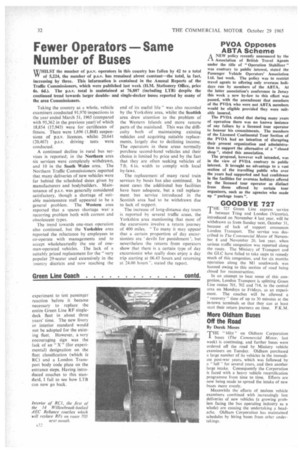Fewer Operators—Same Number of Buses
Page 34

If you've noticed an error in this article please click here to report it so we can fix it.
WHILST the number of p.s.v. operators in this country has fallen by 42 to a total of 5,224, the number of p.s.v. has remained about constant—the total, in fact, increasing by three. This information is contained in the Annual Reports of the Traffic Commissioners, which were published last week (ELM. Stationery Office, price 6s. 6d.). The p.s.v. total is maintained at 76,887 (including LTB) despite the continued trend towards larger doubleand single-decker buses reported by many of the area Commissioners.
Taking the country as a whole, vehicle examiners conducted 91.970 inspections in the year ended March 31, 1965 (compared with 95,362 in the previous year)'of which 18,854 (17,943) were for certificates of fitness. There were 1,696 (1,868) suspensions of p.s.v. licences, whilst 20,641 (20,467) p.s.v. driving tests were conducted.
A continued decline in rural bus services is reported: in the Northern area six services were completely withdrawn, and 10 in the South Wales area. The Northern Traffic Commissioners reported that many deliveries of new vehicles were far behind the scheduled dates given by manufacturers and bodybuilders. Maintenance of p.s.v. was generally considered satisfactory, though a shortage of suitable maintenance staff appeared to be a general problem. The Western area reported that a spares shortage was a recurring problem both with current and obsolescent types.
The trend towards one-man operation also continued, but the Yorkshire area reported the reluctance by employees to co-operate with managements and to accept wholeheartedly the use of oneman-operated vehicles. The lack of a suitably priced replacement for the "very popular 29-seater used extensively in the :ountry districts and now reaching the end of its useful life" was also recorded by the Yorkshire area, whilst the Scottish area drew attention to the problem of the Western Islands and more remote parts of the mainland. This was the difficulty both of maintaining existing vehicles and acquiring suitable replacements. largely due to declining income. The operators in these areas normally purchase second-hand vehicles and their choice is limited by price and by the fact that they are often seeking vehicles of 7 ft. 6 in. width to comply with local by-laws.
The replacement of many rural train services by buses has also continued. In most cases the additional bus facilities have been adequate, but a rail replacement bus service introduced in the Scottish area had to be withdrawn due to lack of support.
The increase of long-distance day tours is reported by several traffic areas, the Yorkshire area mentioning that most of the excursions involve a return journey of 400 miles. To many it may appear that a certain proportion of day excursionists are ' devils for punishment ', but nevertheless the returns from operators show that there is a certain type of day excursionist who really does enjoy a day trip starting at 06.45 hours and returning at 24,00 hours ", stated the report.




















































































































